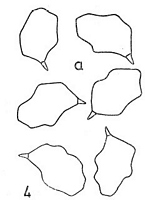|
 Entoloma aethiops Entoloma aethiops
SynonymsAgaricus aethiops
Leptonia aethiops
BiostatusPresent in region - Indigenous
Images (click to enlarge)
Caption: 4-Entoloma sp.: a. spores. |
Article: Horak, E. (1971). A contribution towards the revision of the Agaricales (Fungi) from New Zealand. New Zealand Journal of Botany 9(3): 403-462 (http://www.rsnz.org/publish/abstracts.php).
Notes: Fig. 1 Spore size and shape in the preserved material (COLENSO b 1124) do not agree with
those known for this species in Europe, but undoubtedly the fungus belongs to the genus
Entoloma (Fr.) Kummer.
Article: Stevenson, G. (1962). The Agaricales of New Zealand: III. Kew Bulletin 16(2): 227–237.
Description: This species is described and illustrated by Bresadola, Icon. Mycol. 12, t. 569/2.
These four species [placidum, lampropodum, asprellum, aethiops] have not been collected recently in New Zealand and are not represented in my herbarium. As the material on which the determinations were made over fifty years ago no longer remains at Kew, some doubt may be entertained about the records till these species are collected again.
Article: Massee, G.E. (1899) [1898]. The fungus flora of New Zealand. Transactions and Proceedings of the New Zealand Institute 31: 282–349 Wellington:.
Description: Pileus 1.5-2.5 cm. across, flesh thin, plane, then depressed, not striate, fibrillosely virgate,
shininig, sooty-black, not hygrophanous, but young specimens are black and shining when
dry ; gills adnexed or adnate, straight or ventricose, whitish, edge same colour and quite
entire; stem 3-5 cm. long, hardly a line thick, glabrous, blackish-brown, having black points
near the top; spores irregularly nodulose, salmon-colour, 10 x 7 µ.
Habitat: Among grass, on the ground.
Distribution: New Zealand. Europe.
Notes: Distinguished from its ally, Leptonia lampropoda, by the pileus being depressed from the
first, and the slender stem with black points at its apex.
|